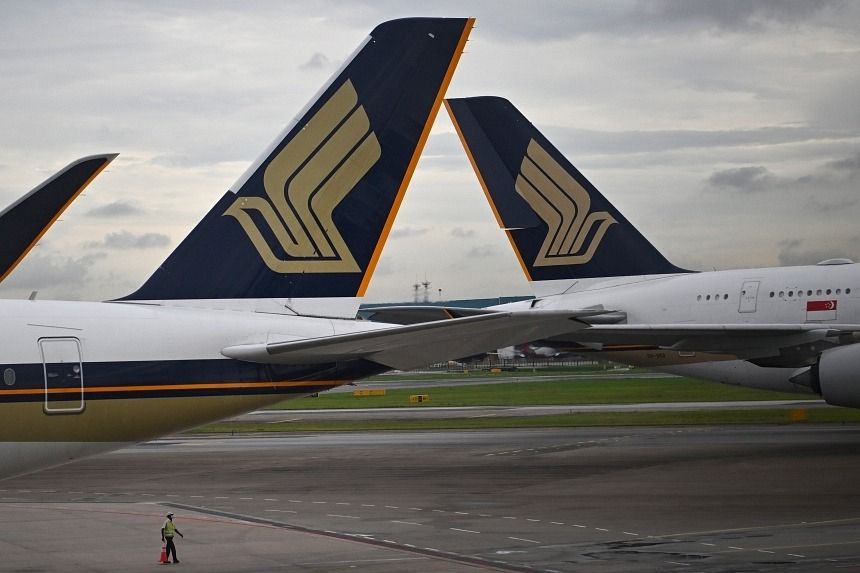
Despite the lucrative summer holiday travel season, SIA reported a rise of just 2 per cent in revenue to S$4.8 billion for the second quarter compared with a year ago. - ST FILE
SINGAPORE: Singapore Airlines (SIA) has signalled that it expects pressure from rising competition to continue despite “robust” demand for air travel.
The warning came as the airline reported a substantial fall in profit for the second quarter of its financial year owing to a gap between passenger traffic and newly deployed capacity, as well as rising costs.
“The operating landscape will continue to be competitive,” SIA said in its results report for the quarter ended Sept 30, released after the market closed on Nov 8.
“The group will remain nimble and agile, adjusting its passenger network and capacity to match evolving demand patterns.”
Despite the lucrative summer holiday travel season, the airline reported a rise of just 2 per cent in revenue to S$4.8 billion for the second quarter compared with a year ago.
This is because it earned less money for each passenger flown as the new capacity that came online during the quarter outweighed growth in passenger traffic.
Meanwhile, costs jumped by 14.7 per cent over the period. They included fuel costs, which rose 10.6 per cent after hedging.
Consequently, the airline’s net profit for the July-to-September quarter more than halved from a year ago, falling 59 per cent to $290 million.
For the first half of its financial year ending March 31, 2025, revenue rose 3.7 per cent year on year to $9.5 billion, while net profit was down 48.5 per cent to $742 million for the period.
This was despite SIA and its wholly owned subsidiary, low-cost carrier Scoot, carrying 19.2 million passengers for the period, a 10.8 per cent year-on-year rise.
The airline, nevertheless, is declaring an interim dividend of 10 cents per share for the half-year, payable on Dec 11.
SIA took delivery of four Boeing 787-10 aircraft in the second quarter, taking the number of passenger planes in its fleet to 146 as at Sept 30. Scoot, meanwhile, operates 52 passenger aircraft.
While passenger demand has yet to catch up with newly available capacity, the additional aircraft will give the national carrier the flexibility to increase flights to take advantage of the popular northern winter season between Oct 27, 2024, and March 29, 2025.
Flight frequencies have already been increased to popular destinations such as Hanoi, Ho Chi Minh City, Johannesburg, Melbourne, Perth, Phuket, Seoul (Incheon), Sydney and Tokyo (Narita).
SIA will also launch a daily service to Beijing in November, and operate supplementary flights to Chitose (Sapporo), Christchurch and Taipei between December 2024 and March 2025.
The carrier plans to boost flight frequencies during the northern summer season between March 30 and Oct 25, 2025, too.
These will include increased weekly services to destinations such as Adelaide, Barcelona, London (Gatwick), Milan and Rome, catering to the mid-year travel demand.
Having additional capacity coming online now might soon also work in the airline’s favour if planemaker Boeing’s recent problems are anything to go by.
Boeing in October cut 17,000 jobs, or around 10 per cent of its workforce, in a move that will delay first deliveries of its 777X jet to 2026. This is after it halted production of its 737 Max, 767 and 777 jets after 33,000 US workers went on strike.
Still, competition for passengers among airlines globally has been heating up at a time when Boeing’s woes are expected to result in capacity constraints across the industry that could last for years, International Air Transport Association director-general Willie Walsh said in October.
Of the 77 passenger aircraft SIA and Scoot have on order, 52 are Boeing planes. Of these, 31 are Boeing 777-9s, which will be affected by the delays.
On Nov 4, SIA announced a $1.1 billion plan to retrofit 41 Airbus A350 long-haul and ultra-long-haul aircraft with newly designed cabins to improve premium travel on its network.
The move, which will be completed in 2030, will include first-class cabins retrofitted in seven A350-900ULR aircraft, while business-class cabins will be upgraded in all 41 aircraft. The first retrofitted plane will be ready by 2026.
The airline added that these are the same seat designs that were meant for the Boeing 777-9 aircraft.
Premium economy and economy-class cabins will also be refreshed, it said.
The move also comes as passengers departing from and transiting at Singapore’s Changi Airport will have to pay progressively higher fees and levies over the next six years, as the airport looks to finance a new $3 billion improvement plan for its four terminals.
The move could deter passengers from passing through Changi, which could, in turn, have an impact on SIA as passengers turn to other options.
Shares in SIA closed on Nov 8 at $6.45. - The Straits Times/ANN










































